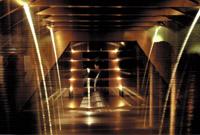Visit to the Plaza de la Física in Geneva
2000/12/01 Roa Zubia, Guillermo - Elhuyar Zientzia Iturria: Elhuyar aldizkaria
They say that physics and science in general does not arouse great curiosity. In some European countries young people do not choose science subjects so it is considered difficult to understand. If this is so, it is absolutely worrying. Within twenty years you can lose the level of research done in our laboratories. At the same time, technological progress would be very slow.
This concern has been reflected in the programme launched by three major European scientific organisations. The three entities are CERN (European Particle Physics Laboratory), ESA (European Space Agency) and ESO (Southern European Observatory). It is a high level concern. "Physics is around us and controls our way of life," they say. "But who has to develop physics within a few years? Maybe not young Europeans."
To address this problem, the three institutions have launched a program called Physics On Stage. There has taken place any informative material of physics, both books and CD-ROM, etc. In November, for a week members from across Europe gathered at CERN headquarters in Geneva to attend the presentation of the best products.
Good reception
Some 500 people from 22 European states gathered at the Geneva conference. Teachers from all fields of science participated. In addition to physicists, including chemists, astronomers, biologists and people from other fields approached the events.
On the one hand, the exchange of information between teachers was encouraged, as personal experience can be helpful to others. On the other hand, in its assembly hall there were also scheduled events to present the works of the winners of the competitions of each country.
The papers presented were generally of two types. The first type was a set of very simple and eye-catching experiments that students can do. The second important type was that of computer products. For example, the influence of the Internet has been very remarkable. The experiments developed with these resources were complex and high-level. It should be mentioned that many subjects have been presented that can be followed in computer media.
Eduardo Zabala, one of the promoters of the program Plaza de la Física, made a special mention to the works taken from Portugal. "It has been the only municipality that has presented the work done by the students," said Zabala. They were very simple and attractive experiments. On the other hand, some peoples have made great efforts in the pedagogical part of the material. For example, several works have been published in circus form. The first objective of this type of work was to awaken the initial interest.
Social insertion
Most of the material brought to Geneva is devoted to teaching. In fact, one of the objectives was to create and strengthen the relationships between teachers in order to work on teaching. However, this material can also be used for collecting ordinary people. In short, scientific disclosure should serve to explain the problems facing science and possible solutions. This was the second main objective of the Plaza de la Física program. Now, therefore, we must work in ways of inclusion.
It must be said that at the moment it is not clear how this insertion work will be carried out. However, in the absence of a thorough evaluation, the three organizing entities have been very satisfied with the results obtained. This program may go ahead, but for now nothing has been determined exactly.

Gai honi buruzko eduki gehiago
Elhuyarrek garatutako teknologia




